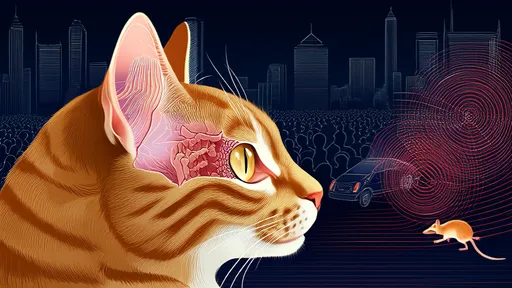In the perpetual arms race between predator and prey, few adaptations prove as remarkable as the feline auditory system. The domestic cat's ability to isolate the faint scurrying of a mouse in a cacophony of urban sounds or rustling leaves borders on the supernatural. This biological sonar doesn't merely detect sounds—it dissects them with surgical precision through specialized neural architectures evolution forged over millennia.
At the heart of this phenomenon lies the auditory filter bank—a cascade of frequency-selective neurons in the cat's cochlear nucleus that function like an array of highly tuned microphones. Unlike human hearing which blurs adjacent frequencies, these filters operate with extraordinary spectral resolution, separating overlapping sounds as distinctly as a prism splits white light. Research from the Journal of Comparative Neurology reveals these filters have bandwidths nearly three times narrower than humans in critical frequency ranges between 500 Hz and 32 kHz, precisely where rodent communication and movement sounds dominate.
The temporal precision of feline hearing defies conventional audio engineering. Where digital signal processors struggle with latency, a cat's neural circuits can resolve time differences of 20 microseconds—allowing them to triangulate a mouse's position within centimeters based solely on the infinitesimal delay between sound reaching each ear. This temporal hyperacuity persists even at intensities below 20 decibels, equivalent to detecting a whisper across a football field.
Neurobiologists have identified specialized "onset neurons" in the feline auditory pathway that act like biological noise gates. These fire exclusively during the initial milliseconds of a sound's attack phase—the critical window when a mouse's claw first contacts the ground. By ignoring sustained background noise and responding only to abrupt transients, cats effectively mute ambient interference while amplifying prey signatures. This explains why sudden sounds like crumpling paper trigger hunting behaviors, whereas continuous noises like refrigerator hums are ignored.
Perhaps most astonishing is the dynamic range compression occurring in the feline inferior colliculus. This midbrain structure applies logarithmic gain to faint high-frequency sounds while suppressing loud low-frequency noise—essentially a biological version of audio ducking technology. Field recordings demonstrate cats can maintain mouse-footstep detection even amidst 90 dB urban noise, equivalent to distinguishing a ticking watch inside a nightclub.
The cochlea's physical morphology contributes another layer of sophistication. Spiral ganglion cells exhibit frequency-dependent directional sensitivity, with high-frequency receptors (15-32 kHz) positioned to maximize reception of sounds originating below the cat—precisely where scurrying rodents generate most acoustic energy. This vertical tonotopy creates an implicit elevation filter, automatically screening out irrelevant sounds from trees or rooftops.
Modern acoustic engineers are now reverse-engineering these biological solutions. Prototype directional microphones mimicking the feline pinna's shape show 18% improvement in signal-to-noise ratio compared to conventional designs. Machine learning algorithms trained on auditory nerve recordings from cats demonstrate superior performance in voice isolation tasks—potentially revolutionizing hearing aid technology. The humble housecat, it seems, has been perfecting noise-cancellation algorithms for 10 million years.
This sensory specialization carries metabolic costs. A cat's auditory system consumes 12% of its total brain energy—three times the human proportion—highlighting the evolutionary premium placed on hunting accuracy. The tradeoff manifests in remarkable behavioral adaptations; felines instinctively angle their heads to exploit spectral notches that amplify high-frequency prey sounds while attenuating wind noise.
As urban environments grow noisier, these adaptations become increasingly valuable. Stray cats in cities develop even sharper frequency discrimination than their rural counterparts—a striking example of accelerated evolutionary tuning. Next-generation bio-inspired audio processors may soon harness these principles, but for now, the most sophisticated mouse-detection system remains curled on your windowsill, ears twitching at sounds we'll never hear.

By /Jun 13, 2025

By /Jun 13, 2025

By /Jun 13, 2025

By /Jun 13, 2025

By /Jun 13, 2025

By /Jun 13, 2025

By /Jun 13, 2025

By /Jun 13, 2025

By /Jun 13, 2025

By /Jun 13, 2025

By /Jun 13, 2025

By /Jun 13, 2025

By /Jun 13, 2025

By /Jun 13, 2025

By /Jun 13, 2025

By /Jun 13, 2025

By /Jun 12, 2025

By /Jun 12, 2025

By /Jun 12, 2025

By /Jun 12, 2025